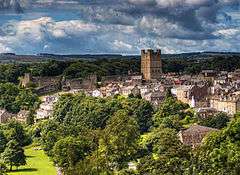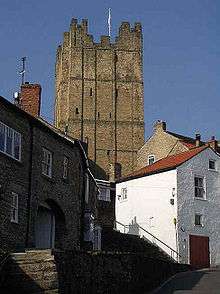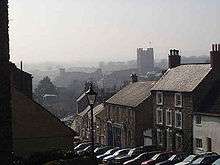Richmond, North Yorkshire
| Richmond | |
 Historic Richmond, with its Norman castle |
|
 Richmond |
|
| Population | 8,413 (2011 census) |
|---|---|
| OS grid reference | NZ170009 |
| – London | 210 mi (340 km) SSE |
| District | Richmondshire |
| Shire county | North Yorkshire |
| Region | Yorkshire and the Humber |
| Country | England |
| Sovereign state | United Kingdom |
| Post town | RICHMOND |
| Postcode district | DL10 |
| Dialling code | 01748 |
| Police | North Yorkshire |
| Fire | North Yorkshire |
| Ambulance | Yorkshire |
| EU Parliament | Yorkshire and the Humber |
| UK Parliament | Richmond |
Coordinates: 54°24′11″N 1°44′13″W / 54.403°N 1.737°W
Richmond is a market town and civil parish in North Yorkshire, England and the administrative centre of the district of Richmondshire. Historically in the North Riding of Yorkshire, it is situated on the edge of the Yorkshire Dales National Park, and one of the park's tourist centres.[1] Richmond is the most duplicated UK placename, with 57 occurrences worldwide.
The Rough Guide describes the town as 'an absolute gem'.[2][3][4] Betty James wrote that "without any doubt Richmond is the most romantic place in the whole of the North East [of England]".[5] Richmond was named UK town of the year in 2009.
The Georgian Theatre Royal in Richmond, built in 1788, is the UK's most complete 18th century theatre.[6]
History
The town of Richemont in Normandy (now in the Seine-Maritime département of the Upper Normandy region) was the origin of the placename Richmond.[7] Richmond in North Yorkshire was the eponymous honour of the Earls of Richmond (or comtes de Richemont), a dignity normally also held by the Duke of Brittany from 1136 to 1399.
Richmond was founded in 1071[8] by the Breton Alan Rufus, on lands granted to him by William the Conqueror. Richmond Castle, completed in 1086, had a keep and walls encompassing the area now known as the Market Place.
Richmond was part of the lands of the earldom of Richmond, which was intermittently held by the Dukes of Brittany until the 14th century. When John V, Duke of Brittany died in 1399 Henry IV took possession. In 1453, the earldom was conferred on Edmund Tudor, and was merged with the crown when Edmund's son Henry became king, as Henry VII in 1485.
During the English Civil War, the Covenanter Army led by David Leslie, Lord Newark, took over the castle and conflict between local Catholics and Scottish Presbyterians ensued.
The prosperity of the medieval town and centre of the Swaledale wool industry greatly increased in the late 17th and 18th centuries with the burgeoning lead mining industry in nearby Arkengarthdale. It is from this period that the town's Georgian architecture originates, the most notable examples of which are to be found on Newbiggin and in Frenchgate . One of Europe's first gas works was built in the town in 1830.[8]
A permanent military presence was established in the town with the completion of Richmond Barracks in 1877.[9]
Landmarks

Richmond Castle in the town centre overlooks the River Swale and is a major tourist attraction. Scolland's Hall is the gatehouse and was staffed by the Lords of Bedale, such as Bryan FitzAlan, Lord FitzAlan, and Miles Stapleton, Founder KG. Other staff residences were Constable Burton and Thornton Steward. Also, Richmond had an extended Wensleydale castlery initially consisting of Middleham Castle, Ravensworth and Snape (Baron FitzHugh & Neville Baron Latymer). The Conyers, Wyville, Gascoigne, Stapleton and Lovell families were all notable gentry.
The cobbled market place is one of the largest in England.[8]
The Green Howards Regimental Museum is in the old Trinity Church in the centre of the town's market place; the town is also home to the Richmondshire Museum.
Swale House on Frenchgate, built around 1750, was home to the headmaster and students of the nearby grammar school, before being used as a hospital for wounded officers in the First World War. For many years, it was the headquarters of Richmondshire District Council, before being closed and sold off in 2013.[10]
The Georgian Theatre Royal, founded in 1788 by the actor Samuel Butler, is off the market place. A decline in the fortunes of theatre led to its closure in 1848 and it was used as a warehouse for many years. In 1963 the theatre was restored and reopened, with a theatre museum added in 1979. More recently, the theatre has become the Georgian Theatre Royal and was extended in 2003 with the addition of a new block providing services and access next to the original auditorium. It is one of Britain's oldest extant theatres.[2]
To the west of the town, on the road to Marske, is the unusually named Richmond Out Moor.

Media and filmography
Richmond has been used as a filming location for a significant number of TV programmes & films including The Fast Show, Century Falls, Earthfasts, A Woman of Substance (1984) and All Creatures Great and Small amongst others.
Local newspapers include the weekly Darlington & Stockton Times and the daily Northern Echo.
Education
The town is home to two secondary schools: Richmond School- a large school and sixth form with specialisms in Performing Arts, Science and Maths- and St Francis Xavier School, which is a smaller, voluntary aided, joint Roman Catholic and Church of England School[11] for boys and girls aged 11–16. There are also three non-sectarian primary schools: Richmond Methodist, Richmond C of E and St Marys Roman Catholic School.
Economy
Tourism is important to the local economy, but the single largest influence is the Catterick Garrison army base, which is rapidly becoming the largest population centre in Richmondshire.[12]
In the town centre there are many independent shops, as well as a small Co-op, WH Smith, Boots, Heron Foods and Edinburgh Woollen Mill. There is a large Co-op situated just outside the town centre.
The Station food, film and art centre admits 300,000 tourists a year.[13] It was formerly Richmond railway station. It has a restaurant, cinema, art gallery and heritage centre, as well as a bakery, cheese-maker, micro brewery, ice-cream parlour, fudge house and honey-maker.[13]
Transport

The stone terminus of Richmond Railway Station, built in a Tudor/Elizabethan style, opened in 1846 and closed in 1968, a year before the branch line itself was taken out of service. After the station closed, the building was used for many years as a garden centre. It has now been renovated by the Richmondshire Building Preservation Trust and opened in late 2007 – retitled, simply, The Station – as a mixed-use space for community and commercial activities.[14] The newly renovated station is home to two cinema screens, an art gallery and a restaurant and café. There are also artisan food makers on the premises: The Angel's Share, Archer's Jersey Ice Cream, Lacey's Cheese, Richmond Brewing Company and Velvet Heaven.
Richmond has a frequent bus service to Darlington and Catterick Garrison, and a wide range of local bus services to nearby towns and villages including Leyburn, Northallerton and Barnard Castle.
Legends
At the end of the 18th century, some soldiers found an entrance to a tunnel underneath the castle keep. They could not fit into the tunnel, so they elected to send a regimental drummer boy. The boy was asked to walk along the tunnel and beat his drum so that above ground the soldiers could follow the noise. They did this for 3 miles before the sound stopped unexpectedly. This was never explained until centuries later, when people now believe that the roof of the tunnel collapsed and caved in on top of the drummer boy, whilst drumming along. Today a stone marks the spot the noise stopped. The entrance to the tunnel is still there, but is forbidden for anyone to go in. Today schools celebrate this local legend with children marching through town annually. Legend claims that on some cold winters night, you can still hear the faint sound of the drummer boy beneath the ground, where the stone stands.[15]
Notable people
Born in Richmond
- Rob Andrew, former rugby union international.
- Alan Ayre-Smith, rugby union international.
- George Bell, publisher, founder of George Bell & Sons.
- Francis Blackburne, archdeacon and dissenter.
- John Brasse, writer.
- William Brice, ethnographer.
- Samuel and Nathaniel Buck, engravers and printmakers.
- Calum Clark, rugby union player.
- Christopher Cradock, Rear Admiral.[16]
- George Cuitt the Younger, painter.
- George Errington, Roman Catholic archbishop.
- John James Fenwick, founder of Fenwick's department stores.
- Henry Greathead, inventor of the lifeboat.
- Brenda Hale, Baroness Hale of Richmond, a Justice of the Supreme Court of the United Kingdom
- Anthony Hammond, legal writer.
- Thomas Harrison, architect.
- Ralph Hedley, painter.
- Joanne Jackson, Olympic swimmer.
- Herbert Sedgwick, first class cricketer.
- Theo Hutchcraft, one half of synth-pop duo, Hurts.
- Francis Johnson, dissenter.
- John Lawrence, 1st Baron Lawrence, viceroy of India.
- Robert Lawrence Ottley, theologian.
- Zoe Lee, European champion rower and Olympic silver medalist.
- Conyers Middleton, clergyman.
- John Peverell, footballer.
- Tanya Robinson, model.
- Tim Rodber, rugby union international.
- Edward Roper, first class cricketer.
- James Tate, headmaster.
- Thomas Taylor, clergyman.
Residents
- Lord Baden-Powell, Founder of the scouting movement.[17]
- Robert Barclay Allardice, pedestrian, educated at Richmond School.[18]
- John Bathurst, physician to Oliver Cromwell.
- Marcus Beresford, Primate of All Ireland.
- Lewis Carroll, author, attended Richmond School, lived in nearby Croft-on-Tees.
- Henry Butler Clarke, historian of Spain.[19]
- J. R. Cohu, headmaster of Richmond School.
- Edward Ellerton, educational philanthropist, educated at Richmond School.[20]
- Charles Grey, 2nd Earl Grey, British Prime Minister. Educated at Richmond School.[21]
- Angela Harris, Baroness Harris of Richmond, Deputy Speaker in the House of Lords.
- Thomas Hounsfield, first class cricketer.
- Samuel Howitt, painter.[22]
- Peter Inge, Baron Inge, former head of the British army.
- Philip Mayne, last surviving British officer of the First World War.
- William Young Ottley, writer on art and collector. Educated at Richmond School.[23]
- George Peacock, mathematician, attended a school in Richmond, one of "Tate's invincibles".[24]
- Donald Peers, singer.[25]
- James Raine, antiquarian, educated at Richmond School, one of "Tate's invincibles".
- Thomas Sedgwick, clergyman.
- Richard Sheepshanks, astronomer. Educated at Richmond School, one of "Tate's invincibles".[26]
- T. H. Stokoe, head of Richmond school.
- Mackenzie Thorpe, artist.[27]
- Stanley Vann, composer.
- John Warburton, herald and antiquary.
Nearby settlements
Twinned locations
References
- ↑ "Richmond." Encyclopædia Britannica. Encyclopædia Britannica Online. Encyclopædia Britannica, 2011. Web. 30 April 2011. http://www.britannica.com/EBchecked/topic/502797/Richmond
- 1 2 Robert Andrews; Matthew Teller (August 2004). The Rough Guide to Britain. Rough Guides. pp. 659–. ISBN 978-1-84353-301-6. Retrieved 14 May 2011.
- ↑ "Weekend Woman's Hour". Woman's Hour. 10 July 2010. BBC Radio 4.
- ↑ Richmond Online – Online Guide to Richmond – A brief History. Richmond.org. Retrieved on 14 May 2011.
- ↑ A kingdom by the sea : an exploration of Northumberland, Durham and the North Riding of Yorkshire James, Betty. p150
- ↑ "Richmond's Georgian Theatre Royal Heritage Lottery grant". BBC News. 15 October 2012. Retrieved 18 October 2012.
- ↑ Curiously the village of Auppegard (Appelgart a. 1160) in the Seine-Maritime département shares the same etymology as Applegarth (Appelgard a. 1160), because of Anglo-Danish farmers who settled in Normandy around the 10th century.
- 1 2 3 Richmond Online Guide to Richmond, Yorkshire. Richmond.org. Retrieved on 14 May 2011.
- ↑ "Exhibition to tell story of barracks". North Yorkshire News. 29 April 2008. Retrieved 13 November 2014.
- ↑ "Councillors say goodbye to historic offices after final meeting". Northern Echo. 1 November 2013. Retrieved 12 April 2015.
- ↑ http://www.sfxschool.org.uk/about.html
- ↑ "Military presence brings massive benefits to North Yorkshire economy". York Press. 22 February 2010. Retrieved 30 January 2016.
- 1 2 Welcome to The Station! Situated in the beautiful Georgian town of Richmond, the ideal base for visitors to the Yorkshire Dales, this converted Victorian rail terminus is now ...
- ↑ Catford, Nick. "Richmond Station". Disused Stations. Retrieved 30 January 2016.
- ↑ Green Howards Museum. "The Legend of the Drummer Boy". Retrieved 19 December 2013.
- ↑ Christopher George Francis Maurice Cradock – Tone's Fighting Ships. Dreadnoughtproject.org. Retrieved on 14 May 2011.
- ↑ Richmond Online - Online Guide to Richmond - A brief History
- ↑ Leslie Stephen, ‘Allardice, Robert Barclay [Captain Barclay] (1779–1854)’, rev. Dennis Brailsford, Oxford Dictionary of National Biography, Oxford University Press, 2004 accessed 7 May 2011
- ↑ DNB · W. H. Hutton, ‘Memoir’, in H. B. Clarke, Modern Spain, 1815–1898 (1906) · J. Fitzmaurice-Kelly, Revue hispanique, 11 (1904), 575–6 · J. Foster, Oxford men and their colleges (1893) · d. cert.
- ↑ G. B. Smith, ‘Ellerton, Edward (1771–1851)’, rev. M. C. Curthoys, Oxford Dictionary of National Biography, Oxford University Press, 2004 accessed 7 May 2011
- ↑ George Moody (1843). The English journal of education, ed. by G. Moody. pp. 351–. Retrieved 14 May 2011.
- ↑ Ruth Cohen, ‘Howitt, Samuel (1756/7–1823)’, Oxford Dictionary of National Biography, Oxford University Press, 2004; online edn, January 2008 accessed 30 April 2011
- ↑ Nicholas Turner, ‘Ottley, William Young (1771–1836)’, Oxford Dictionary of National Biography, Oxford University Press, 2004 accessed 7 May 2011
- ↑ Harvey W. Becher, ‘Peacock, George (1791–1858)’, Oxford Dictionary of National Biography, Oxford University Press, 2004; online edn, May 2009 accessed 2 May 2011
- ↑ Trevor Herbert, ‘Peers, Donald Rhys Hubert (1909–1973)’, Oxford Dictionary of National Biography, Oxford University Press, May 2011; online edn, September 2011 accessed 7 January 2012
- ↑ A. M. Clerke, ‘Sheepshanks, Richard (1794–1855)’, rev. Michael Hoskin, Oxford Dictionary of National Biography, Oxford University Press, 2004 accessed 7 May 2011
- ↑ Mackenzie Thorpe's artist biography & all prints., Buy-FineArt.com
External links
| Wikimedia Commons has media related to Richmond, North Yorkshire. |
| Wikivoyage has a travel guide for Richmond. |
| Wikisource has the text of a 1911 Encyclopædia Britannica article about Richmond, North Yorkshire. |
- A History of Richmond : edited from Langdale's Yorkshire Dictionary (1822) and Baine's Directory of the County of York (1823).
- Robinson's Guide to Richmond (1833).
- A Brief History of Richmond
- Richmondshire Museum.
- Richmond Operatic Society.
- Official Guide to Richmond